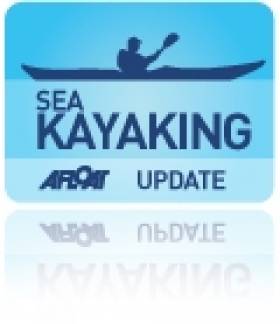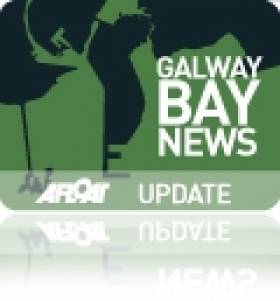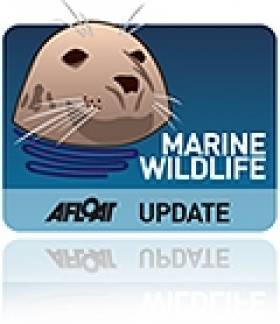Displaying items by tag: Galway Bay
IFI Board Issues Statement on Galway Bay Fish Farm
#GALWAY FISH FARM - The board of Inland Fisheries Ireland (IFI) has issued a statement on the proposed Aran Islands deep sea salmon farm in Galway Bay, which has been the source of some controversy in recent weeks.
The board said it agrees with the recent statement by Minister Fergus O’Dowd on offshore salmon farming, and that it welcomes the development of Ireland’s aquaculture sector "once any development complies with Ireland’s obligations under relevant EU environmental legislation, particularly the Habitats Directive, and does not adversely affect salmon and sea trout stocks."
In addition, the IFI board said it has made a submission on the Environmental Impact Statement (EIS) prepared by Bord Iascaigh Mhara (BIM) for the proposed offshore salmon farm as part of the public consultation process, which is available on the IFI website.
As previously reported on Afloat.ie, the public consultation period began last month for the 500-hectare organic fish farm to be located off Inis Oirr. BIM has applied for a deep sea salmon farming licence at the site, which would be one of the largest of its kind in Europe. If approved, the operation could more than double Ireland's current farmed salmon production rate.
The IFI board's statement notes: "In the submission, concerns were raised in relation to the location and scale of the proposed salmon farm and how its development and operation could impact on wild salmon and sea trout stocks and their habitat.
"These concerns are based on scientific reports by respected authors and knowledge of the impact of existing fish farms on salmon and sea trout populations off the west coast of Ireland."
The submission also highlights "recent peer reviewed international scientific literature on the impacts of sea lice on salmonids" which poses a significant threat to wild salmon in Irish waters, as reported on Afloat.ie.
The board said it does not believe "that the corpus of peer reviewed international scientific literature which recognises the negative impacts of sea lice on salmonids have been adequately dealt with in the EIS".
While welcoming "any sustainable initiative which will provide jobs in rural coastal communities", the IFI board said it questions the figure of 500 jobs it's been reported the 15,000-tonne fish farm project would create, making comparison to a new 2,000-tonne aquaculture scheme in Scotland that's expected to create just four full-time positions.
The board members say they "have serious concerns that whatever the number of jobs created by the current proposal, they will be more than offset by the associated loss of jobs in the recreational angling and tourism sectors" if the scheme results in any negative effects on those areas.
"Ireland's reputation as a pristine wild fishery destination must be safeguarded," they added, noting that proposals for two further offshore salmon farms in Mayo and Donegal "are premature given that significant issues over the current proposal have not yet been resolved.
"No further applications should be progressed until all stakeholders are satisfied that the current proposal is sustainable and has no adverse impact on wild salmon and sea trout stocks."
Inland Fisheries Ireland is the State agency charged with the conservation, protection, development management and promotion of Ireland's inland fisheries and sea angling resource.
Night Sea Kayaking Trips on Kinvara Bay This Winter
#SEA KAYAKING - Outdoors Ireland are running night-time sea kayaking trips on Kinvara Bay on Friday evenings over this winter and spring.
Beginning at 6pm each Friday, you can savour the sights, lights and sounds of Kinvara right on the water as you paddle by sea kayak through this southeastern corner of Galway Bay.
Paddle among deserted islands, listening to the abundant wildlife and possibly catching a glimpse of the gleaming eyes of friendly seals!
Moreover, witness the sight of the sparkling lights of Kinvara Town and the quietly impressive 16th-century Dungaire Castle.
With new sea kayaks, warm equipment provided and a local experienced guide, all abilities are catered for. This is an experience not to be missed next time you are in Galway.
The price is €50 per person for a three-hour kayak trip. For more details or photos please contact [email protected] or 086 860 4563.
Townhouse Adjacent to Charms of Galway Bay
#WATERFRONT PROPERTY - New to the market is an impressive two-bed townhouse adjacent to Galway Bay Sailing Club in Oranmore, which should appeal to anyone with dreams of sailing out west.
As highlighted in the Galway Independent, 15 Renville Court is set in the grounds of Galway Bay Golf Club, just 20 minutes away from Galway city centre and nestled between the charms of Galway Bay and Renville National Park.
The two-storey residence is situated in a quiet and private cul-de-sac and is decorated to a high standard. Accommodation comprises a spacious open plan kitchen/diner/sitting room, two bedrooms (one ensuite) and a main bathroom, with wooden floors throughout.
Viewing is highly recommended by agents Rooney Auctioneers, who have set an asking price of €150,000. More details including images are available HERE.
Retire to a Country Farm with Views from Bay to Burren
#WATERFRONT PROPERTY - Anyone thinking of retiring to the country life should be more than a little tempted by Poppy Lane, a residential farm on the southern shore of Galway Bay now on the market.
Irish Independent Farming reports on the 72-acre property at Killeen Hugh, just four miles from Kinvara and 17 miles from Galway City, with ruggedly beautiful views from the Burren to the sea.
The land consists of mostly fertile ground with no buildings, with water supplied via a private well, with the adjacent traditional four-bed farmhouse has been refurbished in recent years, with oak floors and solid doors.
Agents Keane Mahony Smith have set a guide price of €225,000 for the house and €7,500/acre for the land, with the property also available in lots including the land or the house on their own.
More details of the properly, including images, are available HERE.
BIM Brings Fish Farm Consultation to Aran Islands
#GALWAY FISH FARM - Galway Bay FM reports that a series of direct public consultations on the proposed Aran Islands fish farm in Galway Bay will begin this week.
Bord Iascaigh Mhara (BIM) is organising the meetings on the islands and in nearby Galway City to allow the public to view its proposals for what would be one of the largest aquaculture operations in Europe.
As previously reported on Afloat.ie, the public consultation period began last month for the 500-hectare organic fish farm to be located off Inis Oirr. BIM has applied for a deep sea salmon farming licence at the site some 6km off the island.
If approved, the operation could more than double Ireland's current farmed salmon production rate.
The scheme has faced opposition from local anglers and from Inland Fisheries Ireland, who claim it poses a risk to wild salmon stocks.
But BIM has condemned IFI's "stop everything" attitude regarding the fish farm proposals, while accusing environmental campaigners of being "deliberately alarmist", according to the Galway Independent.
Lobby group Friends of the Irish Environment entered a dispute with the sea fisheries board over the exclusion of an IFI report critical of the salmon farm from the statutory consultation.
“In the current climate, with jobs being as scarce as they are and economic development being the way it is, I think really that sort of attitude, that sort of museum curator ‘stop everything’ attitude is not good enough,” said BIM aquaculture development manager Donal Maguire.
Campaigners In Dispute with BIM Over Galway Bay Fish Farm Report
#GALWAY FISH FARM - Environmental campaigners have retracted their accusation that Bord Iascaigh Mhara (BIM) suppressed a report critical of the proposed deep-sea fish farm in Galway Bay.
The Galway Independent reports on a statement released by lobby group Friends of the Irish Environment, which claimed that BIM tried to hide the study by not posting it on its website along with other materials made available for the public consultation period.
The report in question was commissioned by Inland Fisheries Ireland and is critical of the Environmental Impact Statements carried out on the proposed location for the 15,000-tonne organic salmon farm off the Aran Islands.
As previously reported on Afloat.ie, the salmon farm would be located on a 500-hectare site off Inis Oírr, and would be one of the largest of its kind in Europe, projected to be worth €103 million annually for the economy. The scheme has faced opposition from local anglers who fear it could have a negative impact on wild salmon numbers.
BIM strongly denied any wrongdoing, and the lobby group subsequently retracted its allegations upon learning that the IFI report had missed the deadline for submissions for the consultation.
“BIM certainly did not suppress or ignore or gloss over anything from IFI, because we never received anything," said a BIM spokesperson.
However, Friends of the Irish Environment now alleges that the IFI report was late due to a delay in their receipt of the Environmental Impact Statement from BIM.
The Galway Independent has more on the story HERE.
Kite Surf Pro Kicks Off in Achill Today
#KITESURFING - Ten days of top-class kitesurfing action kick off today (19 October) on Achill Island at the Aer Lingus Kite Surf Pro.
Some 36 riders from 19 countries have converged on Galway Bay to tackle the cold Atlantic waters in what marks the first time the tour has been hosted in Ireland.
As previously reported on Afloat.ie, current world number one Patri McLaughlin will be looking to retain his tour lead in the coming days, but may face a stiff challenge from local wildcard entrants Ryan Coote and Keith McGewon.
Meanwhile, local female wildcard Jade O'Connor will join a field topped by championship leader Ninja Bichler from Germany.
The contest is the penultimate stop on the KSP World Tour for 2012, and will be streamed live online via the official tour website.
It will operate with a mobile format, with riders based at the Pure Magic Lodge on the island and heading out to whatever spot produces the best possible combination of wind and waves on any given day.
Public Consultation on Galway Bay Fish Farm Set to Begin
#GALWAY FISH FARM - Galway Bay FM reports that a full public consultation on proposals for what's set to be Europe's largest fish farm off the Aran Islands is scheduled to begin next week.
As previously reported on Afloat.ie, the 15,000-tonne deep-sea organic salmon farm would be located on a 500-hectare site in Galway Bay off Inis Oírr, and would be one of the largest of its kind in Europe, projected to be worth €103 million annually for the economy.
The statutory consultation period ended earlier this month after delays over the summer in publishing the licence application. And from next Monday 15 October, Bord Iascaigh Mhara (BIM) will make the plan and all statutory feedback available to the public via its website at www.bim.ie.
Advertisements announcing the consultation will appear in local and national newspapers, and packs will also be available to view for locals at Kilronan and Salthill Garda stations, including copies of the environmental impact statements and information on the statutory consultation process.
BIM aquaculture development manager Donal Maguire told Galway Bay FM that transparency is key to ensuring the public had all the information they need regarding the scheme - which has faced opposition from local anglers who fear the fish farm could have a negative impact on wild salmon numbers.
Raw Sewage Outfall Concern for Galway Residents
#GALWAY BAY - Galway residents are voicing fears over pollution in Galway Bay due to alleged increase in outfalls from the city's sewage system.
As Galway News reports, locals in the Claddagh area spotted a discharge of raw sewage into the Claddagh Basin in July, which was confirmed by City Councillor Catherine Connolly to be an outfall.
Such releases are triggered automatically, like a safety valve, in emergency circumstances, such as after heavy rainfall which backs up the system.
Cllr Connolly has expressed her concern over an increase in the number of such releases over recent months, and their potential contribution to the degradation of water quality in the area - especially following the temporary closure of Grattan Beach in Salthill last month due to E.coli contamination.
She has also called for a report from the council on the difficulties experiences at the Mutton Island water treatment plant resulting from the inflow of grease and fats into the system from hotels and restaurants.
Galway News has more on the story HERE.
Wildlife Beach Walk in Salthill
#MARINE WILDLIFE - The Irish Wildlife Trust teams with the Galway Atlantaquaria to host a wildlife walk on Grattan Beach in Salthill tomorrow Saturday 22 September.
Starting at 3.30pm at the lifeguard hut, the free walk will look at the plants and wildlife found in seashore habitats on Galway Bay and around the west coast of Ireland.
Families are especially welcome, and nets and buckets will be provided for adults and children alike to explore the rock pools.
Staff from the Atlantaquaria will be taking along a selection of sea life from their undersea bounty.
And it might also be worth taking the opportunity to get involved in Coastwatch's ongoing 'eco audit' of the Irish shoreline, as previously reported on Afloat.ie.
The Galway Independent has more on the story HERE.






































































